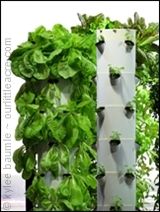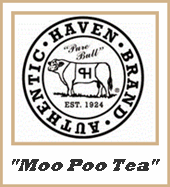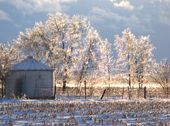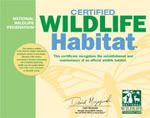"Men and melons are hard to know." ~ Benjamin Franklin
 The Charentais melon laid waiting for me in the midst of a tangle of vines. There were others, including watermelon babies, but this canteloupe looked different. It was pale yellow while its siblings sported a shade of gray-green. I looked at it for a bit, then contemplated whether it was announcing, "Pick me."
The Charentais melon laid waiting for me in the midst of a tangle of vines. There were others, including watermelon babies, but this canteloupe looked different. It was pale yellow while its siblings sported a shade of gray-green. I looked at it for a bit, then contemplated whether it was announcing, "Pick me."I thumped it. No hollow sound. Wait, that only works for watermelons. I tugged on it and it wouldn't let go without a fight. I sniffed it. Mmmmmmmm... Okay, that did it and I broke it from the umbilical cord holding it to its life support, which by now was a shriveling thread with the strength of heavy-duty fishing line. I wondered how nutrients and water could course through such pinched veins, but it's just one of the mysteries of plant life, and come to think of it, maybe that's why the melon was turning yellow.
 Romie took it inside, poised it on the cutting board, and with one fell swoop of the knife, it was split and spilled forth guts of juice and seeds. What was left were two perfect halves of ambrosial sweetness. One for Romie, one for me.
Romie took it inside, poised it on the cutting board, and with one fell swoop of the knife, it was split and spilled forth guts of juice and seeds. What was left were two perfect halves of ambrosial sweetness. One for Romie, one for me.I wish I didn't have to wait a whole year to have this summer treat, but Charentais melons (Cucumis melo var. cantalupensis 'Savor'), a French hybrid, have tender skins and don't transport well. Unless a local grower supplies the grocery store, you likely won't find them there. So we grow them ourselves. I don't know that I'd consider them far superior to the Indiana melons we're used to around here, but they're good enough that I'd recommend trying to grow your own.
Growing melons takes a lot of space, what with the extensive network of vines that results from planting them. We marked out a plot for them this year with a few treated landscape timbers that Romie scavenged from the steel delivery trucks at his work. Once the hills were planted, I laid lightweight landscape fabric over the growing area and cut out holes for the hills. This way, precious moisture would be slower to evaporate under it and the melons wouldn't have to sit on the ground directly and perhaps rot.
 It was a good plan. We've got several canteloupe and watermelon working their way to our plates right now. It's always a problem for me to decide when they're ripe though. How DO you figure that out anyway? There's nothing worse than to pick an unripe melon and be filled with remorse over what might have been. Well, okay, there are worse things, but I hate it when that happens. It's such a waste.
It was a good plan. We've got several canteloupe and watermelon working their way to our plates right now. It's always a problem for me to decide when they're ripe though. How DO you figure that out anyway? There's nothing worse than to pick an unripe melon and be filled with remorse over what might have been. Well, okay, there are worse things, but I hate it when that happens. It's such a waste.I did find some guidelines for knowing when to pick canteloupe:
The best indicator is smell. The melon's fragrance should make your mouth water. It's overripe if it has a strong musky smell.
-
Look for a slight color change from gray-blue to cream, but don't wait for the rind to turn orangish; by then the melon will be overripe.
The melon may slip (detach) from the vine and still taste good, but often it's overripe at this point. Normally, you want to pick a melon before it slips.
Johnny's Selected Seeds recommends examining the smallish, long-stemmed leaf attached to the vine at the same point as the fruit. When fruit is ripe, the leaf is pale.
















 "Bejeweled"
"Bejeweled"



0 comments:
Post a Comment